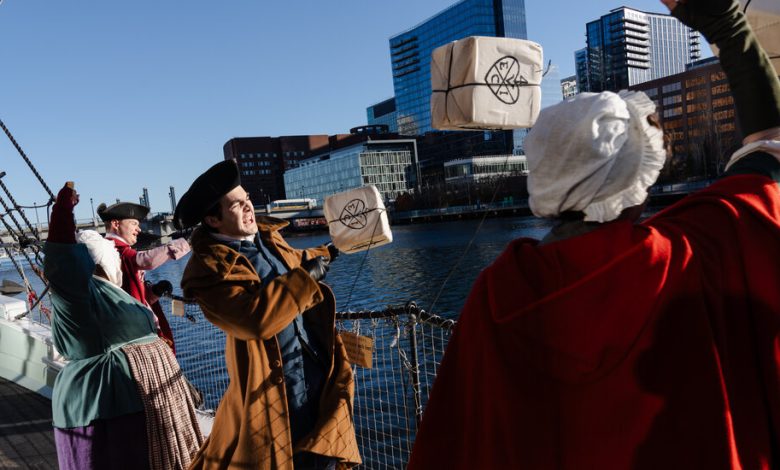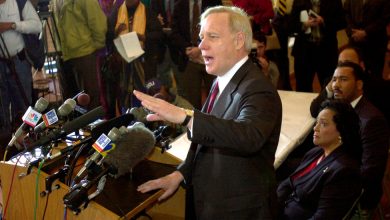The Boston Tea Party Turns 250 and Raises 21st-Century Questions

On Saturday, just as they do every day, a group of costumed people will storm aboard three replicas of 18th-century wooden ships docked in Boston and enthusiastically throw a bunch of tea into the harbor.
But this time, those who gather at the Boston Tea Party Ships and Museum to re-enact the most famous riot in American history will not be everyday tourists. And they will have plenty of reinforcements.
Before the dumping, hundreds of Bostonians will gather at the Old South Meeting House to restage the raucous gathering on Dec. 16, 1773, of citizens outraged by what they saw as illegitimate taxes and other oppressive measures imposed by the British. Outside, they will be joined by thousands for a fife-and-drum-fired “rolling rally” to the wharf, where costumed re-enactors will dump nearly 2,000 pounds of tea donated from all over the world.
The 250th anniversary of the Boston Tea Party is the first major beat in the run-up to the celebration of America’s Semiquincentennial in 2026. For Boston, it is a chance to spiff up its monuments and bring plenty of visitors to town.
But for some planners, the anniversary is also a moment to pose some challenging questions. How do we celebrate the fight for liberty in a period when many Americans, including in Boston, were enslaved? And how do we really feel about protest, violence and revolution today?
Those questions are especially fraught at a time when even the date “1776” itself has become a divisive symbol, said Nathaniel Sheidley, the president and chief executive of Revolutionary Spaces, which operates the Old South Meeting House and the Old State House.
“The commemoration is an opportunity,” he said, “to articulate that the American Revolution wasn’t one struggle, but many.”
Some across the country are keen to emphasize that Boston was hardly the only town riled up about tea in the 1770s. A pamphlet produced by Virginia’s 250th committee lists some 17 tea-related actions in seven states (including a 1774 “Yorktown Tea Party”).
But talking about other tea parties in Boston? Them’s fighting words.
“Boston started the American Revolution,” said Shawn Ford, executive director of the Tea Party Ships and Museum. “Philadelphia did the paperwork. But blood was shed here.”
Jonathan Lane, the executive director of Revolution 250, a consortium of Massachusetts groups, agreed that the Tea Party — and Britain’s extremely harsh response, which stripped Massachusetts of home rule — was the spark that lit the match.
“The idea that what happened in Boston could now happen in any of the colonies is really what brought the American people together,” Lane said.
Not that Bostonians were eager to talk much about the “destruction of the tea” (as it was mostly called at the time) in the years after the Revolution. Many of the city’s elite wanted to distance themselves from Boston’s 18th-century reputation as a “mobbish” town.
It wasn’t until the 1830s that anyone called it a “tea party,” as Alfred Young documented in “The Shoemaker and the Tea Party.” It was a moment of nostalgia for the revolutionary era, whose last survivors were passing from the scene. It was also a time of radical workingman’s activism, as emerging labor unions claimed the mantle of the Revolution.
Young’s book, published in 1999, was itself was a salvo in a long-running battle among historians of early America, pitting those who saw the Revolution as a top-down affair driven by the high-flown ideals of the Founders and those who wanted to acknowledge its class dynamics (and its radical heirs today).
That fight has largely died down. Today, many historians see the Revolution against the wider backdrop of the British Empire, and the Boston Tea Party as a global event linking tea growers in China, British traders, enslaved Africans, Native Americans and proper tea-drinking Bostonians.
Kenzie Bok, a former Boston City Council member (and a historian) who wrote the ordinance setting up Revolution 250, said it’s important to show that Boston’s revolutionary legacy has relevance to today’s diverse Boston.
Bok, who is now the head of the Boston Housing Authority, cited a recent talk at the Old State House by a Haitian-born Bostonian, about connections between the American Revolution and the 1804 Haitian Revolution. She also mentioned the 2019 “Boston T Party” campaign led by Boston’s current mayor, Michell Wu (then a member of the City Council), as a protest against transit fare hikes.
At that time, Bok said, the phrase “tea party” still conjured up the insurgent Republican movement that arose after the election of Barack Obama.
The transit campaign “was an effort to reclaim the Boston Tea Party narrative for Boston, and for collective civic advocacy,” she said.
In Boston, the Tea Party story has become more diverse in recent years. In 2019, the Tea Party Ships introduced a costumed interpreter depicting the poet Phillis Wheatley, the first American of African descent to publish a book. As it happens, the first print run of Wheatley’s book — which also turns 250 this year — was on one of the tea ships. (The books were unharmed, as was the rest of the non-tea cargo. No crew members were injured.)
Wheatley is also the subject of “Phillis in Boston,” a new play by the British-Nigerian playwright Ade Solanke, which just closed at the Old South Meeting House (where Wheatley herself was a member of the congregation).
“1773 was also the year enslaved Bostonians and their allies started bringing petitions to the provincial government,” demanding freedom, Sheidley noted.
The nature of freedom — and what tactics are justified to win it — remains a divisive question today. “Impassioned Destruction: Politics, Vandalism and the Boston Tea Party,” an exhibition at the Old State House, looks at moments of politically motivated property destruction across American history, and poses a question: When is it justified “to violently destroy property in the name of a cause?”
Matthew Wilding, the exhibition’s curator, said the idea started taking shape on Jan. 6, 2021, when he was watching television coverage of the assault on the Capitol by supporters of President Donald J. Trump.
In his early days as a costumed interpreter on Boston’s Freedom Trail, Wilding depicted a Bostonian who participated in the Stamp Act Riots of 1765. But watching the events at the Capitol, he said, “I realized what I had never experienced was the seriousness of a full-scale riot.”
Back in 1773, the Tea Party was itself highly polarizing. The British royal governor denounced it as an act of treason. While many patriots celebrated it, Ben Franklin and George Washington were appalled, denouncing property destruction as an illegitimate tactic. (The more than 92,000 pounds of tea tossed overboard would be worth between $1.5 million and $1.8 million today, the anniversary’s planners estimate.)
And the fractures extended to individual families. “Impassioned Destruction” includes a decorated tea caddy from the household of a prominent Bostonian, whose wife (the story goes) threw its contents into the harbor after he refused to do it himself.
Other events covered in the show include the 1877 Reading Railroad Strike in Pennsylvania (where workers burned a number of train cars, setting off riots that left roughly a dozen people dead), and the Weather Underground’s 1974 bombing of the Gulf Oil Company’s headquarters in Pittsburgh.
Assembling the Jan. 6 section was particularly fraught, Wilding said. Some visitors have said that including the Capitol riot somehow “validated” the event, he said. A few others have angrily disputed the statement that seven people lost their lives in connection with the Capitol riot.
Visitors may also wonder about a notable absence. As one person wrote earlier this month on the feedback blackboard at the end of the show: “Where was the BLM/George Floyd summer of violence? More violent, deadly, costly than Jan. 6.”
What to call the property destruction during the racial justice protests following the murder of George Floyd in 2020 — looting? rioting? vandalism? — and whether it could be labeled violence was among the most charged aspects of the protests. Some journalists (and museum curators) who criticized the destruction of statues or buildings were disciplined or fired.
Sheidley said leaving out those protests was a matter not of caution, but of space (the gallery space is just 1,100 square feet) and philosophy. The Jan. 6 riot, he said, “is more directly analogous to the Tea Party, since the destruction of property was done to impede the execution of the law.”
At three different points in the exhibition, visitors are invited to drop a penny on one side of a scale, weighing in on the same question: “Do you believe that the participants in the Boston Tea Party were justified in destroying the tea?”
The results vary across the exhibition, Sheidley said, and change day by day. One afternoon earlier this month, the first scale said “yes,” as did the second one (though just barely).
But the final one, placed right after the Jan. 6 display, weighed heavily toward “no.”




